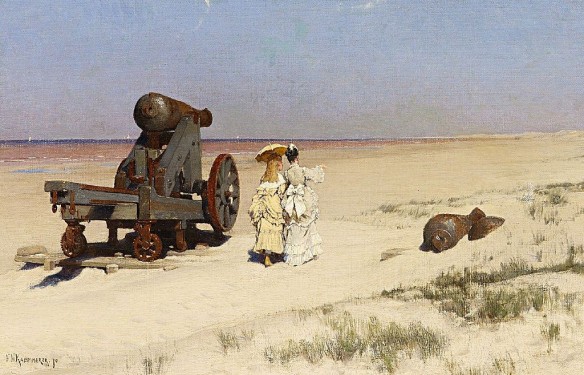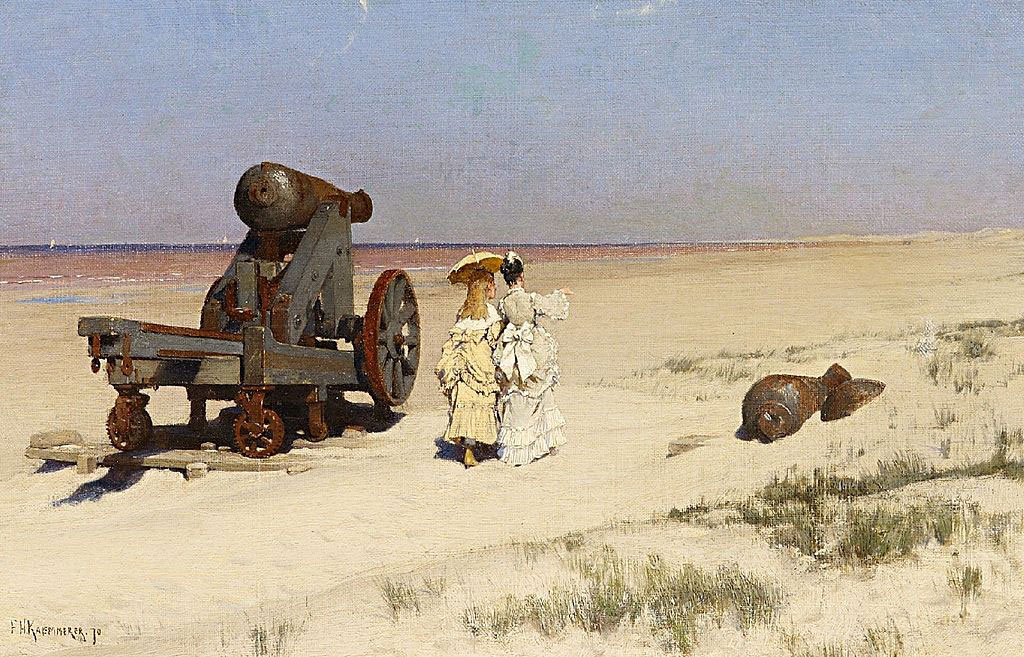
“Am Strand” 1870, by Dutch painter Frederik Hendrik Kaemmerer. Image source: Public Domain / Wikimedia
Excerpts;
Along the southwestern coast of the Netherlands, not far from The Hague, kite surfers glide on the waves around a huge sand peninsula where beachcombers photograph seagulls.
But the peninsula is more than just a recreation spot. It’s also an experiment in coastal management: It keeps the sea away from nearby cities.
The Dutch call it “De Zandmotor” — the Sand Motor, also known as the Sand Engine…
Read Full Article, NPR (11-25-2017)
Looking to Holland to find more sand for Galveston Island, Texas, HPM University of Houston (08-30-2016)
For years, sand has been returned to eroded beaches and dunes on Galveston Island by bulldozers and backhoes at a cost of millions of dollars. Now, a new idea: let Mother Nature do the work…
Dutch Unveil Plan In War Against The Sea: A Sandbar, AFP / TerraDaily (12-20-2011)
In its age-old war to keep back the sea, low-lying Netherlands has dumped sand onto a surface larger than 200 football fields just off the coast, and will wait for nature to do the rest…
The Netherlands: Sand Motor conference to take place in September; Dredging News Online (08-09-2016)
Five years after the creation of the Sand Motor, the initial research results from this pilot project will be presented with respect to coastal safety, innovation, nature and recreation. It will be the central focus of a two-day international conference…
Sand-engine to protect against coastal erosion, UK; PhysOrg (10-29-2015)
Belgium is to build its first artificial island off the coast, as climate change mitigation; Le Figaro (10-04-2016)
Amid rising seas, Belgium plans on building an artificial island off its coast, in a step towards climate change mitigation. 8 millions euros have been provided in funding of the project study…
The world hungers for sand; Deutschland DE (09-26-2017)
Sand, Rarer Than One Thinks: A UNEP report (GEA-March 2014)
Despite the colossal quantities of sand and gravel being used, our increasing dependence on them and the significant impact that their extraction has on the environment, this issue has been mostly ignored by policy makers and remains largely unknown by the general public.
In March 2014 The United Nations released its first Report about sand mining. “Sand Wars” film documentary by Denis Delestrac – first broadcasted on the european Arte Channel, May 28th, 2013, where it became the highest rated documentary for 2013 – expressly inspired the United Nations Environment Programme (UNEP) to publish this 2014-Global Environmental Alert.
Let’s end war with ocean, Op-Ed by Orrin H. Pilkey
The immediate future most certainly holds more miles of sandbags, resulting in more narrowed and ugly beaches.But this trend can be halted and reversed. Now is the time to make peace with the ocean.The time is now to stop sandbagging, both physically with no more shore-hardening structures, and politically with no more exceptions to the intent of the rules, no more undermining existing legislation, and a return to enforcement…
Rethinking Living Shorelines, By Orrin H. Pilkey, Rob Young, Norma Longo, and Andy Coburn;Program for the Study of Developed Shorelines / Western Carolina University, March 1, 2012, Nicholas School of the Environment, Duke University
In response to the detrimental environmental impacts caused by traditional erosion control structures, environmental groups, state and federal resource management agencies, now advocate an approach known as “Living Shorelines”that embraces the use of natural habitat elements such as indigenous vegetation, to stabilize and protect eroding shorelines.









